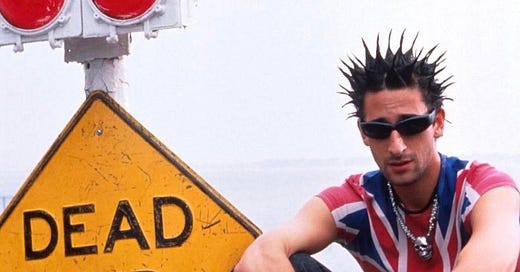Adrian Brody’s show at Eden Fine Art is amazing.
I’m extremely amused by how many artists still cling to the idea of meritocracy like it’s some sacred truth. The notion that a toxic, nepotistic industry actually uplifts great art, and not just trending work or those who can pay to play, is dissolving right in front of us. The old-school belief in talent and taste is a myth. The principles of art were shattered a long time ago in this neoliberal, militarized world.
Brody went straight to the auction house, fetching $425,000 for a painting he made yesterday or the day before. Iconic. He doesn’t need to rely on the boys’ club of alcoholic gallery owners. His inbox is already full of overpriced PDFs featuring RISD grads whose markets will tank by the March auctions. He’s investing in himself, using his social capital and his Oscars to eclipse the industry entirely.
What’s the difference between Adrian Brody and Maurizio Cattelan? Not much. We’re in an era where Joy Division and Nickelback could both support apartheid and people would still debate who’s the better musician. For every Basquiat impersonator, there’s a Kippenberger impersonator. Both are accepted into Art Basel Switzerland. There is no high and low anymore, just sanctioned access.
Cool is now just a modulation of self transmitted into consumerism. That’s where the fury comes from. Former mall rats are crying into their 40s, confused as to why a failing magazine like Interview would showcase the art show of an Oscar-winning actor, when it’s obvious Brody brings more eyeballs and more press than the entire Dimes Square radius. With more interest in Interview, maybe they’ll sell a few more subscriptions. Everyone wants to be at the private dinner. No one wants to pay.
Banksy, KAWS, and Mr. Brainwash? Lowbrow.
Everything at the struggling LES galleries, where half the artists are addicted to ketamine? Highbrow.
Neither is especially great until a celebrity cosigns it.
“Oh, I heard Adrian Brody bought something from 53 Canal.”
Snoozefest.
The “integrity” of the art world and its journalism doesn’t challenge this dynamic. In fact, it protects it. It’s worse than an Adrian Brody show. It’s why an Adrian Brody show works. Everyone is ready to line up for Robert Nava at Pace. Everyone wants to be bathed in the sweat of Jeff Koons. Everyone wants proximity to whiteness, to capital, to power.
It doesn’t matter whether it’s a gun pointed at a painted image of Basquiat’s head or a quiet candlelit dinner with Elizabeth Peyton and former indie producers who drop Adrian Brody’s name to legitimize themselves. No one has the teeth to denounce Brody’s show at Eden Fine Art. And frankly, Eden is the perfect space for this spectacle.
I’m excited to attend my first art show in 2025 at Eden Fine Art. I’m also looking forward to his next one in Cannes or Marbella, surrounded by 80-pound models who still have Jeffrey Epstein’s number saved in their phones. At least that crowd isn’t pretending to be moral. At least the A-list actors are actually in the room. And honestly, you might walk away with a job. Nanny, dog walker, personal assistant. A livable wage. Which is more than I can say for most gallery openings.
Outside of that, it’s not that different from the grungy New England post-post realism galleries of the East Village, charged by it-people who are now senior citizens managing long-term heroin addictions. It’s not more or less racist. It’s just better funded. And people seem happier, because they’re actually wealthy.
Made in America might be one of the most significant shows of the last ten years. Not because it’s groundbreaking, but because it opened in the shadows of ruins. It’s not Sonic Youth. It’s more Son of Sam. But that’s Adrian’s youth: graffiti, cartoons, and the Basquiat mythos. That’s the spark he’s anchored to.
The New Yorker in me knows exactly who Adrian Brody is. The kind of guy who carried a sketchbook as a kid. Who had a dream. A dream that didn’t die. He didn’t go to art school. If he had, he probably would’ve sharpened his technique. He’d also be more depressed.
He wouldn’t have become an actor. He’d be in an apartment he bought in 1997, holding onto his last real moment of public attention. He’d be dating a 25-year-old Gagosian gallery assistant and bitter about the black figurative painting boom. He’d reminisce about that one time he did coke with Adrian Brody at Scorsese’s house, still hoping that story makes someone laugh.
And he’d have nothing to show for it but that girlfriend, a contorted legacy, and an active Reddit account where he spills industry gossip anonymously.
But instead, Adrian Brody is the gossip. He’s the name dropped at dinners, the wildcard collector, the “wait, he buys?” that somehow makes everything more desirable. He didn’t fight to be let in. He didn’t have to. He is the prospective collector. He is the institution.
He doesn’t need to write a manifesto or pretend his work is about collective healing. He doesn’t have to be radical or broke or likable. He just has to be Adrian Brody.
And in 2025, that’s more than enough.
Maybe that’s what makes his show so powerful. It exposes just how little it takes to win. Not because the bar is low, but because the system was never built to recognize anything outside the glow of celebrity, money, and myth.
In a broken game, Adrian Brody is a great artist.
And maybe that’s what pisses everyone off the most.





thank you